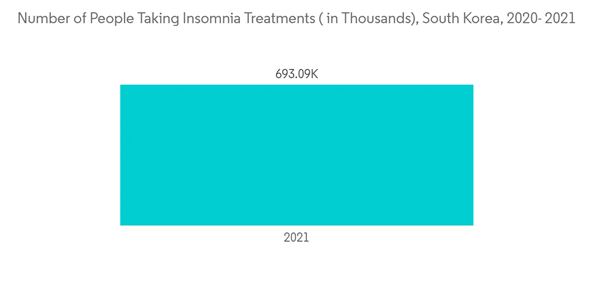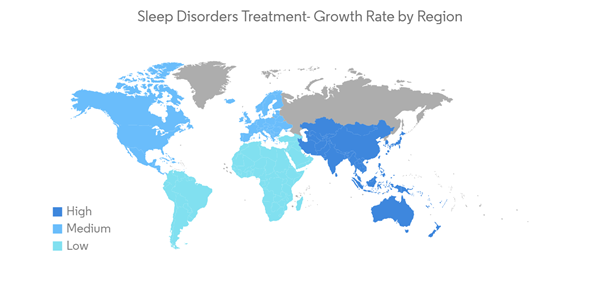The sleep disorders treatment market is anticipated to witness a CAGR of nearly 7.1% during the forecast period.
COVID-19 had a significant impact on the growth of the market. According to the NCBI article published in March 2022, in Europe, the incidence of new-onset COVID-19-related insomnia was as high as 13.6%, whereas the prevalence of clinical insomnia was 18.6% in 2021. According to another study published in September 2020 in Springer, the patients with obstructive sleep apnea experienced around eight times greater risk for COVID-19 infection compared to a similar-aged population receiving care in a major racially and socio-economically diverse healthcare system. Obstructive sleep apnea was linked to an increased risk of hospitalization in COVID-19 infection patients, as well as a nearly doubled risk of developing respiratory failure. Thus, the COVID-19 infections had a significant impact on the growth of the market. The increasing adoption of sleep disorder treatment is expected to drive the growth of the market over the coming five years.
The major factors driving the market include the increasing incidences of sleep apnea, an increase in the geriatric population, an increase in the prevalence of obesity and hypertension, and increasing awareness among the patient population in developing countries. Aging is a major factor driving the market growth for sleep apnea devices as the elderly are the most at risk for developing this disorder.
The increasing prevalence of sleep disorders and the increasing awareness among people about sleep disorders across the world are contributing to the market's growth. As per the Helsestart data on global insomnia statistics in 2022 and 2023, half of US adults experience insomnia once a month or more. Around 59% of adults in the West suffer from insomnia at some point or another, making it the most susceptible region in the world. The same source also stated that people in Japan, Taiwan, and Sweden have the biggest struggle with insomnia, more than any other country worldwide. Norway has the most searches for melatonin in the world, i.e., a massive 520 times per 100,000 people from 2021 to 2022, 67 more times than Sweden.
An increase in awareness about sleep disease among the general population is expected to propel the sleep disorders treatment market. The rising number of people suffering from a host of sleep disorders, including hallucinations, sleep paralysis, disrupted nocturnal sleep, insomnia, sleep apnea, narcolepsy, and circadian disorders, caught the attention of governments across the world, forcing them to take necessary steps to address this condition.
The approval and commercialization of new drugs by market players are also expected to play a crucial role in driving the market in the coming years. For instance, in January 2022, Idorsia received FDA approval for the drug Quviviq for the treatment of insomnia, which may improve sleep with less grogginess. Similarly, in August 2021, Jazz Pharmaceuticals received US FDA approval for its drug Xywav for the treatment of patients with idiopathic hypersomnia, a rare neurologic disorder that can result in daytime sleepiness despite having a prolonged night of sleep.
However, lower diagnosis rates and side effects of sleep disorders drugs may hamper the market's growth.
The increasing drug approvals for insomnia are also expected to contribute to the growth of the studied segment. For instance, in June 2022, Daridorexant, a drug used to treat insomnia, was approved in Europe for the improvement of sleep-related disorders and conditions. In July 2021, Esai Co. Ltd launched the in-house discovered and developed orexin receptor antagonist DAYVIGO for treating adults with insomnia, characterized by difficulties with sleep onset.
Increasing awareness campaigns about the disease and the available treatment options leading to early diagnosis and increasing healthcare expenditure are anticipated to drive this segment’s growth over the forecast period. For instance, in January 2022, the National Sleep Foundation launched Sleep Awareness Week to reemphasize the important connection between sleep and health.
Thus, such factors are expected to drive the growth of the segment over the forecast period.
According to the American Academy of Sleep Medicine (AASM) 2020, stress can cause adjustment insomnia, which affects up to 20% of the US population each year. Children with poor sleeping habits are more likely to develop behavioral insomnia, which affects 30% of children. The same source stated that, in 2021, nearly 51% of Americans reported using sleep aids during the COVID-19 pandemic. Such increasing awareness of sleep medication in the United States is expected to drive the growth of the market during the forecast period.
Thus, such factors are expected to drive the growth of the market in the region during the forecast period.
This product will be delivered within 2 business days.
COVID-19 had a significant impact on the growth of the market. According to the NCBI article published in March 2022, in Europe, the incidence of new-onset COVID-19-related insomnia was as high as 13.6%, whereas the prevalence of clinical insomnia was 18.6% in 2021. According to another study published in September 2020 in Springer, the patients with obstructive sleep apnea experienced around eight times greater risk for COVID-19 infection compared to a similar-aged population receiving care in a major racially and socio-economically diverse healthcare system. Obstructive sleep apnea was linked to an increased risk of hospitalization in COVID-19 infection patients, as well as a nearly doubled risk of developing respiratory failure. Thus, the COVID-19 infections had a significant impact on the growth of the market. The increasing adoption of sleep disorder treatment is expected to drive the growth of the market over the coming five years.
The major factors driving the market include the increasing incidences of sleep apnea, an increase in the geriatric population, an increase in the prevalence of obesity and hypertension, and increasing awareness among the patient population in developing countries. Aging is a major factor driving the market growth for sleep apnea devices as the elderly are the most at risk for developing this disorder.
The increasing prevalence of sleep disorders and the increasing awareness among people about sleep disorders across the world are contributing to the market's growth. As per the Helsestart data on global insomnia statistics in 2022 and 2023, half of US adults experience insomnia once a month or more. Around 59% of adults in the West suffer from insomnia at some point or another, making it the most susceptible region in the world. The same source also stated that people in Japan, Taiwan, and Sweden have the biggest struggle with insomnia, more than any other country worldwide. Norway has the most searches for melatonin in the world, i.e., a massive 520 times per 100,000 people from 2021 to 2022, 67 more times than Sweden.
An increase in awareness about sleep disease among the general population is expected to propel the sleep disorders treatment market. The rising number of people suffering from a host of sleep disorders, including hallucinations, sleep paralysis, disrupted nocturnal sleep, insomnia, sleep apnea, narcolepsy, and circadian disorders, caught the attention of governments across the world, forcing them to take necessary steps to address this condition.
The approval and commercialization of new drugs by market players are also expected to play a crucial role in driving the market in the coming years. For instance, in January 2022, Idorsia received FDA approval for the drug Quviviq for the treatment of insomnia, which may improve sleep with less grogginess. Similarly, in August 2021, Jazz Pharmaceuticals received US FDA approval for its drug Xywav for the treatment of patients with idiopathic hypersomnia, a rare neurologic disorder that can result in daytime sleepiness despite having a prolonged night of sleep.
However, lower diagnosis rates and side effects of sleep disorders drugs may hamper the market's growth.
Sleep Disorders Treatment Market Trends
Insomnia Holds Notable Share in the Market and is Expected to Continue to Do the Same During the Forecast Period
Insomnia is expected to dominate the sleep disorders treatment market through the forecast period, attributed to the rising prevalence of insomnia, which causes severe, irresistible daytime sleepiness and sudden loss of muscle tone. In 2021, the NIH estimated that roughly 30% of the general population complains of sleep disruption, and approximately 10% have associated symptoms of daytime functional impairment consistent with the diagnosis of insomnia. The NCBI article published in 2021 also mentioned that insomnia afflictions were a chronic pattern among more than 10% of the European population.The increasing drug approvals for insomnia are also expected to contribute to the growth of the studied segment. For instance, in June 2022, Daridorexant, a drug used to treat insomnia, was approved in Europe for the improvement of sleep-related disorders and conditions. In July 2021, Esai Co. Ltd launched the in-house discovered and developed orexin receptor antagonist DAYVIGO for treating adults with insomnia, characterized by difficulties with sleep onset.
Increasing awareness campaigns about the disease and the available treatment options leading to early diagnosis and increasing healthcare expenditure are anticipated to drive this segment’s growth over the forecast period. For instance, in January 2022, the National Sleep Foundation launched Sleep Awareness Week to reemphasize the important connection between sleep and health.
Thus, such factors are expected to drive the growth of the segment over the forecast period.
North America is Expected to Hold Significant Share in the Market During the Forecast Period
North America is expected to dominate the market for sleep disorders, and it is expected to continue its stronghold for a few more years. The increasing prevalence of sleep disorders, rising awareness, growing demand for sleep disorder treatment in the United States and Canada, and high healthcare spending are anticipated to drive the market. In addition, favorable reimbursement policies for therapeutic products, a strong clinical pipeline, and rising stress levels are other factors anticipated to promote revenue growth. According to the American Psychological Association (APA) survey of 2020, adults rated their stress levels as 5.0 on a scale of 1 to 10 in 2020. Stress levels among Gen Z adults slightly rose in the last two years, increasing to 6.1 in 2020.According to the American Academy of Sleep Medicine (AASM) 2020, stress can cause adjustment insomnia, which affects up to 20% of the US population each year. Children with poor sleeping habits are more likely to develop behavioral insomnia, which affects 30% of children. The same source stated that, in 2021, nearly 51% of Americans reported using sleep aids during the COVID-19 pandemic. Such increasing awareness of sleep medication in the United States is expected to drive the growth of the market during the forecast period.
Thus, such factors are expected to drive the growth of the market in the region during the forecast period.
Sleep Disorders Treatment Market Competitor Analysis
The sleep disorders market is moderately fragmented, with several manufacturers offering generics. Although few players offer branded drugs, price sensitivity is an issue in several regions. Companies focus on developing new chemical entities and novel molecules to obtain a higher revenue share. The major players include companies such as Takeda Pharmaceuticals USA Inc., Vanda Pharmaceuticals Inc., Merck & Co., Mylan NV, Pfizer, and Teva Pharmaceuticals USA Inc.Additional benefits of purchasing the report:
- The market estimate (ME) sheet in Excel format
- 3 months of analyst support
This product will be delivered within 2 business days.
Table of Contents
1 INTRODUCTION
4 MARKET DYNAMICS
5 MARKET SEGMENTATION (Market Size by Value - USD million)
6 COMPETITIVE LANDSCAPE
Companies Mentioned (Partial List)
A selection of companies mentioned in this report includes, but is not limited to:
- Dr Reddy's Laboratory
- Merck & Co.
- Mylan NV
- Pfizer
- Sanofi SA
- Takeda Pharmaceuticals Inc.
- Teva Pharmaceuticals Inc.
- Transcept Pharmaceuticals
- Vanda Pharmaceuticals Inc.
- Zydus Cadila
- Meda Consumer Healthcare
- Cerêve Inc.
Methodology

LOADING...










